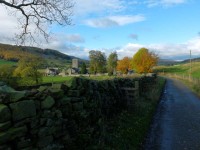Kerfies, Cleggies and all that.
Saint Andrew's Church
Tucked away in Swaledale, St Andrew’s Church in Marrick is a quiet sentinel of centuries past. This Grade II listed building stands on the site of what was once the priory church of a 12th-century Benedictine nunnery, Marrick Priory. The priory was founded between 1140 and 1160 by Roger de Aske and flourished until the Dissolution of the Monasteries in 1539. After the nuns were evicted, the nave of the church continued to serve the local parish, a tradition that endured until the mid-20th century. Architecturally, the church is a fascinating blend of medieval and later elements. The west tower, dating from the 13th century, is a sturdy three-storey structure with mullioned belfry openings and a stair turret. The nave, rebuilt in 1811, incorporates Perpendicular-style windows and a striking round window with a quatrefoil design. Inside, fragments of medieval stained glass and Jacobean woodwork hint at the church’s long and layered history. The chancel, now in ruins, still bears traces of sedilia and a piscina, silent witnesses to its monastic origins. Today, the church forms part of the Marrick Priory Outdoor Education Centre, which repurposed the site in the 1970s. While no longer used for regular worship, the building continues to serve the community in a new way—welcoming young people for outdoor learning and adventure. It’s a beautiful example of how heritage can be preserved not just in stone, but in spirit.

